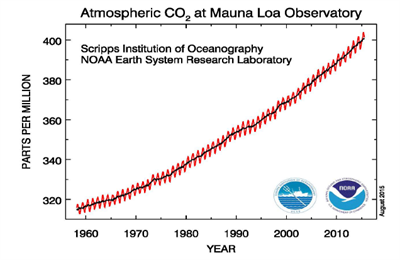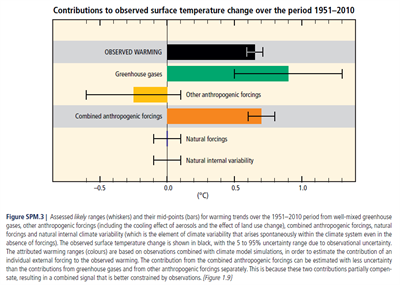The Izaak Walton League recognizes climate change as a critical risk to the future sustainability of our soil, air, woods, waters, and wildlife, and advocates for the implementation of mitigative actions to reduce the impacts of climate change to sustain our natural resources for the benefit of future generations.
Read on to learn more about the causes of climate change, the current and predicted impacts of climate change, and the history of climate science.
Climate Science
Based on exhaustive study of multiple lines of long-term evidence, 97 percent of climate scientists agree that climate change is real, is happening now, and is overwhelmingly caused by human activity. Each fact listed here is from an authoritative source, which is noted in parentheses. Click any annotation to see the original source. Click any image to see a larger version.
Atmospheric Carbon Dioxide and Average Global Temperatures Are Rising
"Atmospheric CO2 concentration... is now at its highest level is 3 million years." (Testimony of James Hansen, an eminent climate scientist)
Atmospheric CO2 has been rising rapidly over the past several decades of careful daily record-keeping. (The Keeling Curve, the definitive record of CO2 concentrations in the recent past.)

“Anthropogenic greenhouse gas emissions… [have] led to atmospheric concentrations of carbon dioxide, methane and nitrous oxide that are unprecedented in at least the last 800,000 years. Their effects, together with those of other anthropogenic drivers, have been detected throughout the climate system and are extremely likely [greater than 95 percent likelihood] to have been the dominant cause of the observed warming since the mid-20th century.” (Intergovernmental Panel on Climate Change 2014 report)
Climate Change Is Happening Now
“Warming of the climate system is unequivocal, and since the 1950s, many of the observed changes are unprecedented over decades to millennia. The atmosphere and ocean have warmed, the amounts of snow and ice have diminished, and sea level has risen. … Each of the last three decades has been successively warmer at the Earth’s surface than any preceding decade since 1850. The period from 1983 to 2012 was likely [greater than 66 percent likelihood] the warmest 30-year period of the last 1400 years in the Northern Hemisphere.” (Intergovernmental Panel on Climate Change 2014 report)
Climate Change Is Not Due to Natural Causes
“It is extremely likely [greater than 95 percent likelihood] that more than half of the observed increase in global average surface temperature from 1951 to 2010 was caused by the anthropogenic increase in GHG [greenhouse gas] concentrations and other anthropogenic forcings together. The best estimate of the human-induced contribution to warming is similar to the observed warming over this period." (Intergovernmental Panel on Climate Change 2014 report)

“In point of fact, warming of Earth caused by the increasingly thick CO2 ‘blanket’ persisted even during the recent five-year solar minimum from 2005-2010. Had changes in insolation [energy received from the sun] been the dominant forcing, the planet would have had a negative energy balance in that period, when solar irradiance was at its lowest level in the period of accurate data, i.e., since the 1970s. Instead, even though much of the greenhouse gas forcing had been expended in causing observed 0.9 degrees C global warming to date, the residual positive forcing from CO2 emissions overwhelmed the negative solar. This illustrates, unequivocally, that it is human activity, and not the sun, that is the dominant driver of recent climate change.” (Testimony of James Hansen, an eminent climate scientist)
"So how do we know [we're not just in a warming cycle following the last ice age]? Because the warming after the last ice age peaked 8,000 years ago. That's right – according to [natural] cycles, we should be gradually sliding into the next ice age over the next few thousand years.” (Video by Katharine Hayhoe, a climate scientist and professor)
We Have Known About Climate Change for a Long Time
“[The] American Petroleum Institute alerted its members [in 1954] that burning fossil fuels [was] increasing atmospheric CO2.” (Presentation by Naomi Oreskes, professor of Earth Science and History of Science. Download the PowerPoint slides.)
In 1965, the President's Science Advisory Committee noted in a report: “By the year 2000 the increase in atmospheric CO2 will be close to 25 percent. This may be sufficient to produce measurable and perhaps marked changes in climate. … The climate changes that may be produced by the increased CO2 content could be deleterious from the point of view of human beings.” ("Restoring the Quality of Our Environment")
Climate Change Is Not a Conspiracy by Scientists
Of 928 papers about climate science published in refereed scientific journals between 1993 and 2003, none disagreed that climate change is real and is caused by increasing greenhouse gas concentrations due to human activity. (The short but groundbreaking paper "The Scientific Consensus on Climate Change")
After divvying up a $1.1 million research grant with their colleagues and their employer, a climate scientist has just enough left to hire a grad student as an assistant – and certainly none of that money is going into their personal bank account. (Video by Katharine Hayhoe, a climate scientist and professor)
Scientists Have Not Overstated the Problem
“Global temperature increases over the past 25 years [from 2009] have been consistent with model predictions (0.19 degrees C per decade), while other important impacts are proceeding faster than expected, including CO2 emissions, increased rainfall in already rainy areas, continental ice-sheet melting, arctic sea-ice decline, and sea level rise.” ("Erring on the Side of Least Drama")
Climate Solutions
The Izaak Walton League has long recognized climate change as a threat to the natural world that we have been defending since 1922. Fortunately, we also recognize many effective and practical solutions that improve wildlife habitat and conserve natural resources in addition to mitigating the danger posed by climate change. Here are a few we are actively advocating.
Sequester carbon in our soils, grasslands, and wetlands
About 40 percent of the continental United States is in agricultural production. Farmers and ranchers can contribute significantly to carbon sequestration efforts through the management and preservation of soil health, grasslands, and wetlands.
Practices that improve soil health, like cover crops and rotational grazing, can greatly increase the amount of carbon that soil is able to sequester. By adopting improved soil heath practices across the country, farmers can capture carbon emissions, reduce the need for fertilizers and pesticides, improve water quality, and produce more nutritious foods. Lawmakers should boost working lands programs, like the Conservation Stewardship Program and Environmental Quality Incentives Program, so that more farmers can implement practices that improve soil health.
Grasslands and wetlands are also tremendous carbon sinks, sequestering tons of carbon every year in every acre. In fact, an acre of grassland can sequester more carbon than an acre of forest! By protecting these important ecosystems, farmers and ranchers are helping reduce the amount of carbon in our atmosphere, as well as protecting vital wildlife habitat. Conservation easement programs in the Farm Bill help landowners conserve wetlands and prairie, and the Conservation Reserve Program has a set of funds specifically dedicated to preserving intact grasslands.
The role producers play in carbon sequestration can be dramatically increased by adding more agricultural land to established conservation programs like the Conservation Reserve Program. Producers can also be a big part of the solution if we help them by establishing new carbon sequestration programs that incentivize protecting grasslands and wetlands, leaving marginal land untilled, and improving soil health.
Improve Energy Efficiency
The U.S. simply cannot reduce its greenhouse gas emissions to acceptable levels without addressing energy efficiency. In fact, some states could meet between 25 and 100 percent of their pollution reduction goals simply by increasing energy efficiency.
We can drastically reduce dependence on fossil fuels by promoting public policies that use voluntary or regulatory measures to manage energy consumption and reduce demand. From uniform building codes and weatherization assistance grants to more efficient household items (like lightbulbs), many policy solutions to increase conservation and curb greenhouse gas emissions are readily available and more must be explored.
Build Resilience into our Ecosystems
Our changing climate is having impacts today. A key part of addressing climate change is building as much resilience into our natural systems as we can. Improving resilience involves assessing how climate change will create new risks or alter existing risks, and taking steps to better cope with these risks. Healthy, natural ecosystems will adapt to a changing climate more easily than those that have become polluted and fragmented. Fortunately, the League has been advocating for decades for policies that produce healthy ecosystems, and we know that these healthy and restored natural systems are going to be most resilient to a changing climate.
Now is not the time to shrink from this vital work. In fact, we must scale up the successful programs and policies that have protected and restored our forests, wilderness areas, wetlands, oceans, and fish and wildlife habitat. Instead of loosening protection for clean water, for example, we should be expanding protections for streams and wetlands because ecosystems will handle a changing climate much better if they are healthy. Protecting habitat will be essential to helping wildlife cope with a changing climate. The programs that are good for habitat now, like the North American Wetlands Conservation Act, will be even more important in the future to help our fish and wildlife populations adapt to climate change.
Expand Research and Development
To combat climate change, we must dramatically expand our search for solutions to climate and energy problems. As we transform to a clean energy economy, issues we have not had to confront in the past will arise. How will we store and transmit electricity generated by clean energy sources like solar and wind? How can we increase the power and lifetime of batteries as we move away from a transportation infrastructure dependent on fossil fuels?
As we prepare to meet these challenges, we must dramatically scale up investment in the agencies and programs that will develop the solutions that are needed. Additionally, private sector research and development must be encouraged and incentivized. One way to spur this development of new technologies is to supercharge the Advanced Research Projects Agency-Energy (ARPA-E). This government agency awards grants to private energy researchers to facilitate high-potential, high-impact energy technologies.
News about Climate Change
-
09/25/2023
While the U.S. Supreme Court’s recent
Sackett v EPA decision spells bad news for wetlands and water quality nationwide, a ray of hope for conservation burst out of a Montana court on August 14.
Held v Montana is a first-of-its kind victory for affirming the human right to a safe and livable climate system.
Full story
-
03/13/2023
The latest draft of the National Climate Assessment paints a dire portrait of how life in America has already been impacted by accelerated climate change and how perilous it might become unless urgent action is taken. We summarize seven key takeaways.
Full story
-
04/15/2022
The latest assessment from UN scientists leaves no doubt that the situation is serious – but it also shows many ways that we can address the problem while securing additional benefits for people and the environment. We’ve rounded up five inspiring opportunities for action.
Full story